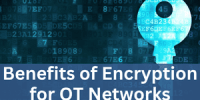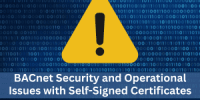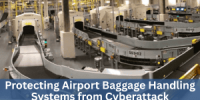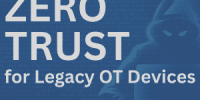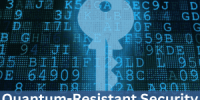Benefits of Encryption for OT Networks
Key Points Why OT Needs Encryption Now: Historically air-gapped OT systems avoided encryption due to isolation, performance concerns, and device limitations, but modern connectivity and remote access have made unprotected communications a major cyber risk. Key Security Benefits: Encryption prevents unauthorized access, stops man-in-the-middle attacks, protects sensitive operational data, supports regulatory compliance, and maintains system…
Read More BACnet Security and Operational Issues with Self-Signed Certificates
Key Points Security Risks Without Trusted Validation: Self-signed certificates lack third-party verification and a root of trust, making BACnet/SC systems vulnerable to spoofing, impersonation, and man-in-the-middle (MitM) attacks. Operational Complexity and Inefficiency: Managing self-signed certificates is time-consuming and error-prone, requiring manual generation, distribution (e.g., via USB), and renewal—especially problematic in large-scale deployments. Downtime and Renewal…
Read More Zero Trust Security for Microgrids and Energy Control Systems
Key Points Growing Cyber Risk in Microgrids: The distributed nature, two-way data flows, and device diversity in microgrids greatly expand the attack surface, making traditional perimeter-based security insufficient. Limitations of Legacy Security: Older “verify then trust” models lack device-level authentication/encryption, leaving systems vulnerable if an insider device is compromised and failing to protect at Purdue…
Read More Protecting Airport Baggage Handling Systems from Cyberattack
Key Points Growing Cyber Risk for BHS: Airport baggage handling systems, running on legacy OT hardware and insecure protocols like Modbus and BACnet, are increasingly vulnerable to ransomware, insider threats, and state-sponsored cyberattacks. High Impact of Disruption: A BHS outage can cause major operational delays, lost luggage, passenger frustration, and even compromise sensitive passenger data.…
Read More Cybersecurity Challenges in Retrofitted Smart Buildings
Key Points Legacy Systems Are Inherently Vulnerable: Most retrofitted buildings rely on outdated OT devices and insecure protocols (like BACnet and Modbus) that lack basic cybersecurity features such as encryption and authentication. Integration Increases Risk: Retrofitting often connects legacy OT systems to modern IT networks without proper segmentation, exposing buildings to lateral movement and cyberattacks.…
Read More Zero Trust Security for Legacy OT Devices
Key Points Legacy OT Challenges: Many older OT systems use insecure protocols, lack modern security features, and have limited hardware resources—making them difficult to protect using traditional cybersecurity methods. Zero Trust Integration Options: Three primary methods exist—device replacement (costly), software-defined networking (limited protection), and security overlays (most effective and non-intrusive), with overlays offering encryption and…
Read More Quantum-Resistant Security for IoT and M2M Devices
Key Points Quantum Threat to Existing Encryption: Quantum computers will be able to break today’s widely used encryption methods (like RSA and ECC) in minutes, making current IoT and M2M device security obsolete. IoT/M2M Vulnerabilities: These devices have long lifespans, limited ability to receive updates, and often perform critical functions—making them high-value targets for future…
Read More Securing Critical Infrastructure to Reduce OT Cyber Risks and Impacts
Webinar Summary – Securing Critical Infrastructure (OT) In the webinar about securing critical infrastructure hosted by KMC Controls, the panelists discussed critical infrastructure and the importance of hardening operational technology (OT) against cyber vulnerabilities. The session featured insights from Sandy Kline, Louis Parks, and Paris Stringfellow, who shared their extensive experience in cybersecurity and operational…
Read More Zero Trust Security for Building Management Systems in Data Centers
Key Points Cooling and Power Risks: While power failures are the top cause of serious data center outages, 13–19% result from cooling issues, with notable incidents caused by extreme heat. Cyber Threats to Environmental Systems: Attackers can overheat servers via workload manipulation, compromise HVAC controls through DCIM systems, or sabotage power systems—causing performance loss, hardware…
Read More Zero Trust vs Remote Access VPN for Building Control Systems
Zero Trust architecture fundamentally transforms how organizations secure their building automation networks by addressing the inherent vulnerabilities of traditional remote access VPN-based security. Key Points VPNs Grant Broad Access; Zero Trust Enforces Least Privilege: VPNs give authenticated users full network access, while Zero Trust limits each user or device to only the specific resources needed,…
Read More 
